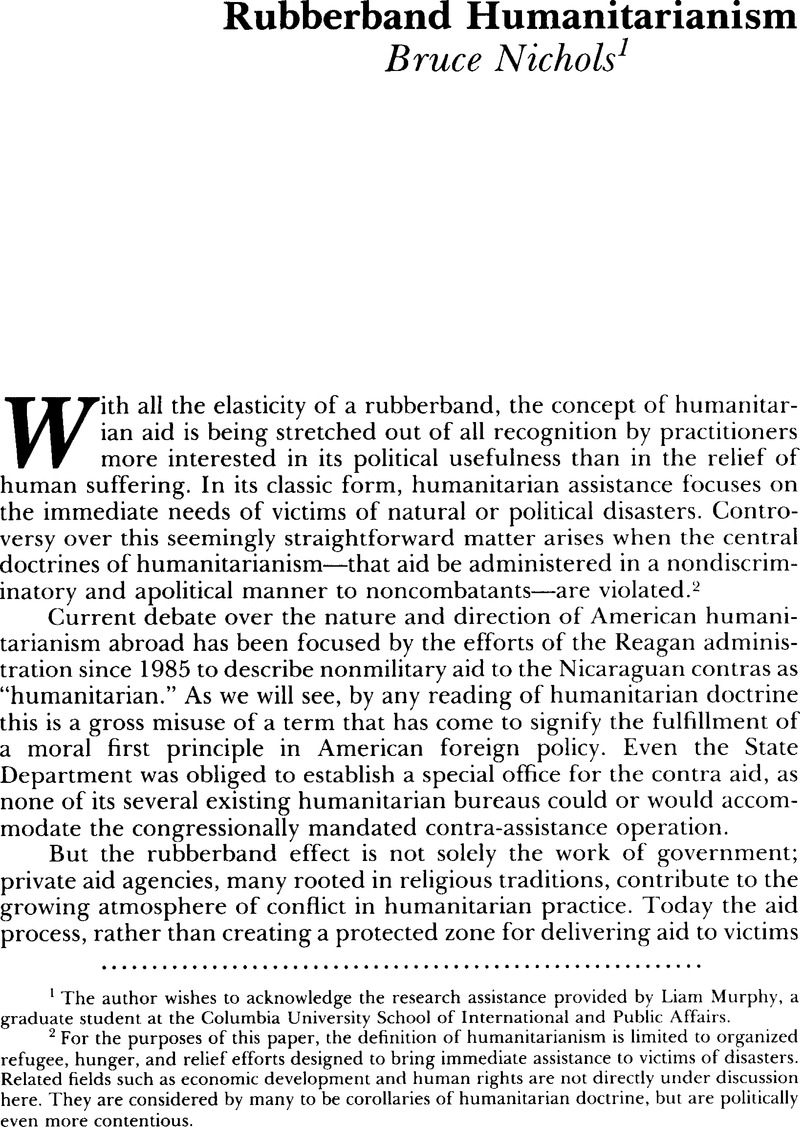Published online by Cambridge University Press: 28 September 2012

2 For the purposes of this paper, the definition of humanitarianism is limited to organized refugee, hunger, and relief efforts designed to bring immediate assistance to victims of disasters. Related fields such as economic development and human rights are not directly under discussion here. They are considered by many to be corollaries of humanitarian doctrine, but are politically even more contentiousGoogle Scholar.
3 Jewish and Christian bodies have become increasingly organized and less informal in their efforts at international humanitarianism in the twentieth century; both traditions had the rudiments of humanitarian (rather than strictly missionary) service in place by the late nineteenth century. An Islamic relief society existed in Turkey as early as the 1860s. While such Islamic groups have not enjoyed the same steady growth as their Christian and Jewish counterparts, they expanded rapidly in the 1970s and 1980s, particularly in North Africa and the Middle EastGoogle Scholar.
4 See, respectively, First Geneva Convention of 1949, Articles 12 and 18, and Fourth Geneva Convention of 1949, Articles 59–63 (for the text of these passages see UN Treaty Series 75, Iff.)Google Scholar;
5 Macalister-Smith, Peter, International Humanitarian Assistance: Disaster Relief Actions in International Law and Organization (Dordrecht: Martinus Nijhoff, 1985)CrossRefGoogle Scholar. This is one of the best catalogs of efforts to codify humanitarian practices.
6 A current effort is the sanctuary movement, organized by religious leaders to shelter Central American refugees from deportation by the U.S. Immigration and Naturalization Service. While the movement has been successful in commanding media attention, it has had little or no effect in advancing the notion that the U.S. government has acceded to a comprehensive set of international humanitarian obligations, as defense lawyers claimed in the 1986 trial of sanctuary workers in Tucson. They argued that sanctuary was a means of upholding the law (i.e., respecting U.S. international humanitarian obligations)Google Scholar.
7 The emphasis on the independence of the voluntary sector has been supported from a variety of sources. For instance, the Nathan Commission, formed in the early 1950s in Great Britain to study the relationship between private and public agencies in providing a broad range of welfare services, concluded that voluntary action is most true to its genius when it is “not controlled or directed by the State… [I]t is the meeting by private enterprise of a public need.” This view emphasizes voluntary action as an alternative to state servicesGoogle Scholar.
8 For example, the Trading with the Enemy Act (1917), the Espionage Act (1918), the sweeping National Security Directive 68 (1950), and various Supreme Court decisions limiting the freedom and civil liberties of citizens abroad have given the President broad powers to restrict overseas relief shipments or fundamental domestic rights such as the freedom to travelGoogle Scholar.
9 Pope Pius XI, “Reconstructing the Social Order [Quadragessimo anno],” in Five Great Encyclicals (New York: The Paulist Press, 1939) 125–68Google Scholar.
10 Quoted in Douglass, James W., “Catholicism, Power and Vietnamese Suffering,” in Quigley, Thomas, ed., American Catholics and Vietnam (Grand Rapids: Eerdmans, 1971) 102Google Scholar.
11 See for instance Miller, Robert W., “Voluntary Agencies in Vietnam, 1966–1971,” unpublished Master's thesis (University of Pittsburgh, 1973)Google Scholar.
12 “Text of Vatican Document on Liberation Theology,” New York Times (April 6, 1986)Google Scholar.
13 From the time of World War II, it has been clear that the multiplicity of private agencies required centralized coordination with government policies overseas. The American Council of Voluntary Agencies served this critical function from 1943 until 1984, when it was dissolved and most of its members joined a new effort, Inter ActionGoogle Scholar.
14 This and subsequent quotations are taken from “Humanitarian Organizations and Politics,” Working draft (Geneva: International Council of Voluntary Agencies, February 1983)Google Scholar.
15 “A Statement on the Nature of Humanitarian Assistance” (June 1985)Google Scholar.
16 The signers included officials of World Vision Relief Organization, Lutheran World Relief, the American Friends Service Committee, Church World Service, Grassroots International, Interchurch Medical Assistance, American Near East Refugee Aid, Oxfam America, the Heifer Project International, the Christian Children's Fund, and the Board of World Mission of the Moravian Church. Medical Mission Sisters was the only Catholic agency to sign the statementGoogle Scholar.
17 “Humanitarian Aid to Nicaragua: Statement of the Board of Directors” (Philadelphia: American Friends Service Committee, July 1985); also “Quaker Group Pledges Continued Support to Nicaragua; Prepares Humanitarian Aid Shipment,” news release (Philadelphia: American Friends Service Committee, July 12, 1985)Google Scholar.
18 “U.S. Aid to the Contras: Humanitarian? Logistical? Defensive?” advertisement in the New York Times (April 7, 1986) 9Google Scholar.
19 “U.S. Approves Gift of Contra Copter,” New York Times (April 30, 1986)Google Scholar. License disputes, like the battles over statutory language separating security and economic assistance, have consistently been an arena for efforts at defining humanitarian assistance abroad. In recent years a restrictive policy has been followed for licenses to ship humanitarian aid to such places as Cuba, North Korea, and Vietnam. In 1982 the Mennonite Central Committee (MCC) and its supporters raised a public furor when the MCC was denied a license to ship school kits to Cambodian children. In this case the license was eventually granted.
20 Contradictions and Inconsistencies in Humanitarian Aid to the Contras (Boston: Oxfam America, April 1986)Google Scholar.
21 “InterAction Policy on Humanitarian Assistance,” final draft (New York: InterAction, 1986)Google Scholar.